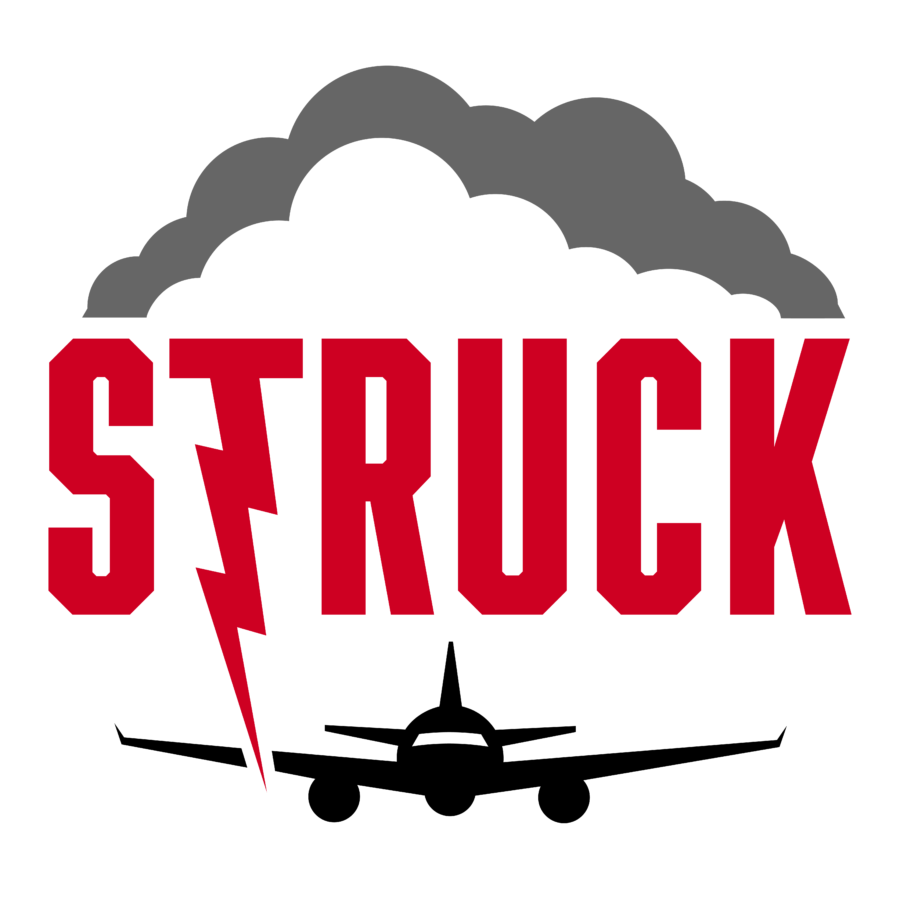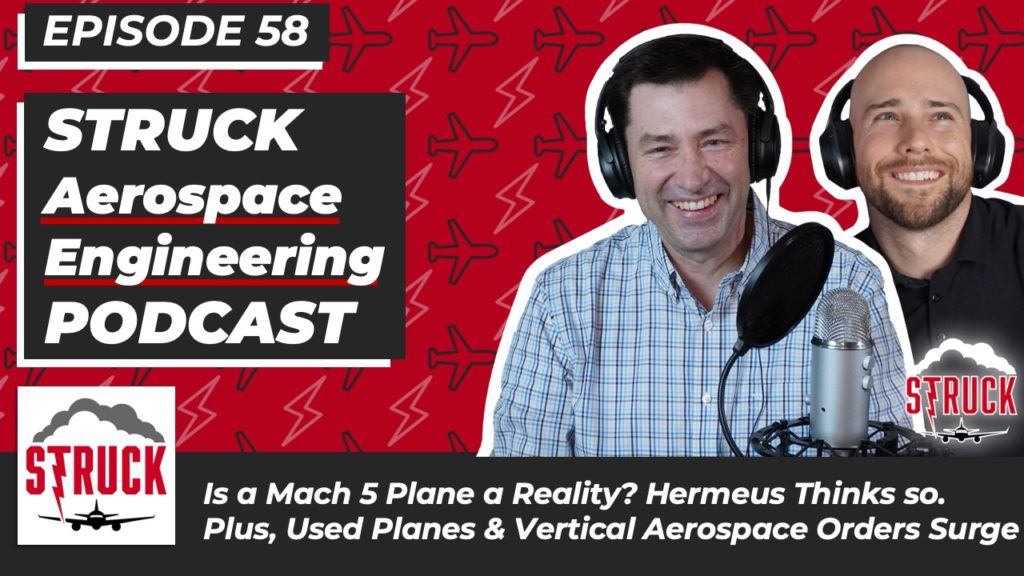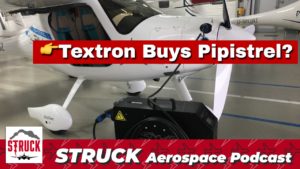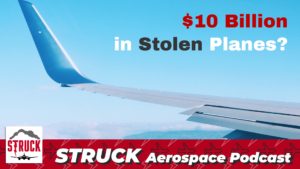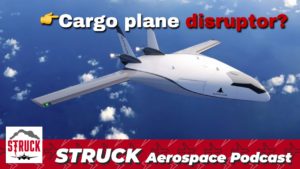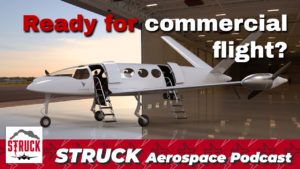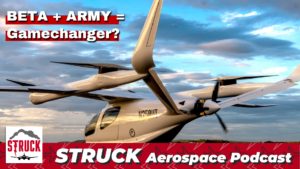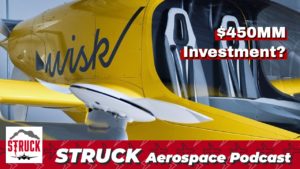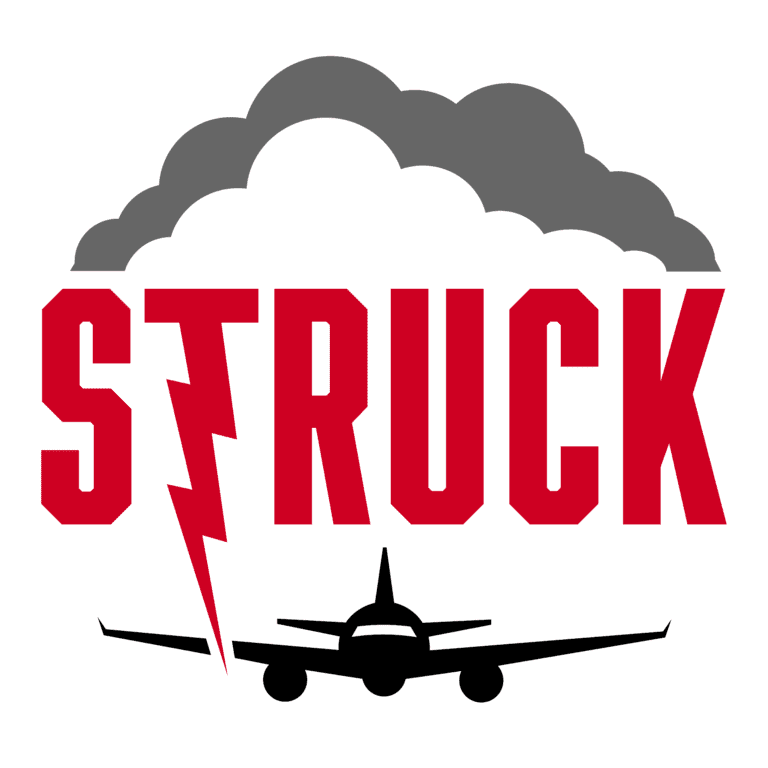In this episode we discuss plane discounts – are used Airbus A330s a viable plane in today’s market? The Hermeus team is trying to get a Mach 5 plane to market within five years, and is working with the Air Force on a Mach 5 Air Force One – is this realistic? Plus, Vertical Aerospace is going public with a SPAC merger, and has taken on a significant number of orders lately – are they surging ahead in the EVTOL race, despite no flight demonstrations to date?
Learn more about Weather Guard StrikeTape segmented lightning diverters and aircraft lightning protection consulting services. Follow the show on YouTube, Twitter, Linkedin and visit us on the web. Have a question we can answer on the show? Email us!
Podcast: Play in new window | Download
TRANSCRIPT EP58 – Hermeus Mach 5 a Reality? Vertical Aerospace Orders Surge and Are Used Planes a Thing?
0:00
This episode is brought to you by Weather Guard Lightning Tech at Weather Guard. We support design engineers and make lightning protection easy.
You’re listening to the stroke podcast. I’m Dan Blewett.
0:18
I’m Allen Hall.
0:19
And here on struck we talk about everything aviation, aerospace engineering and lightning protection.
Alright, welcome back to the struck aerospace engineering podcast. I’m your co host, Dan Blewett. On today’s episode, we’re going to talk about used planes, how long do they last? And what’s the market like for older Airbus and Boeing aircraft? And is this going to hurt their sales of new aircraft, and our engineering segment we’ll talk about Hermeus. They are looking to create a Mach 5 aircraft and they are working in conjunction with the Air Force to develop the next Air Force One Mach addition. So we’ll talk about some of the engineering challenges that will come out of them. And then there are a VTOL segment lots on Vertical Aerospace today, which they’ve been in the news quite a bit. 2 billion worth of orders from Avalon, which entails quite a bit of quite a lot that gets 500 plane orders. American Airlines has also put an order for 250 planes, Virgin Atlantic 150. So there’s a lot going on here. And it looks like they’re gonna go public with SPAC merger. So lots in the in the news about Vertical Aerospace, and they admittedly have a beautiful looking prototype. I’m into it. But we’ll see what Alan has to say. So first, Alan, let’s chat about USD plane. So especially popular right now is the Airbus a 330, with smaller airlines who want to save money or startups, and they can be reduced, sometimes up to close to 50% of their sticker price. What are like what’s the deal with the a 330? And why is it so it’s such an attractive use plane and what what kind of routes can the a 330 fly?
2:07
Well, it’s a bigger airplane. So it’s a twin aisle airplane. So it’s it’s made for longer haul routes. Similar to what like a triple seven would do. And the but that airplane is much older in terms of when it was developed. The problem with anything as twin owl right now is that there’s not a lot of long route flights going on anywhere in the world. Forget about you know, United States, Europe is really hard you still now so there’s there’s just a depressed market. There’s a lot of airplanes, twin, all airplanes that are parked right now. And obviously, the newest ones are going to retain most of their value, but the older ones are gonna have a hard time especially older designs are gonna have a hard time maintaining their value through this just because they’re older designs, you can buy a new one for also a discounted or newer one for a discounted price. Why wouldn’t I do that? You totally what. And I think a lot of times in these down situations and COVID has been one big downer for the airline industry, airplane models just disappear for the most part or they are they shift where their main focus is they get because they’re just less expensive to operate, they can be operated by a lot of airlines that couldn’t otherwise afford them. And so you’ll you’ll see, older airplanes show up in different parts of the world where it just they need something it’s a little less expensive to operate and to own. This would be a good buying opportunity. opportunity if you had cash to go out and do it. You know Airbus makes good airplanes buying makes good airplane. So pretty much if you buy one with a good service history on it, and good maintenance records on it. You know what you’re getting for the most part. And so, you know, if you have cash and you’re an airline may be a good buying opportunity. It just whether the government’s will open up enough where you can actually fly those airplanes without all your passengers being inconvenienced with still have making people do COVID tests and all the other things that happen.
4:05
Well, if you get a bigger plane like an A 330, cheap enough, does it make sense to fly it at less than capacity? Like could you fly domestic routes and a 330 and never be full? Or does that not make sense?
4:16
It doesn’t make sense based on fuel prices. Now even though fuel prices have been relatively stable, the expectations the fuel prices are going to start bumping back up again as global traffic starts to increase. And once that does, once that happens, then part of your benefit goes away because fuel prices are so much a driver in profitability. Obviously, passenger load is one part of it and then fuel costs on the other and labor costs on the other. That’s going to be the downside. And that’s why you see a lot of the airlines more expansive, like a Delta or united or this airport, all kinds of at that level of airlines at that level. really pushing like fuel economy, right. That’s why the the NEOs are playing a big, have a big market and great airplane, obviously 737 Max is the same trying to fill that same niche, which is lower fuel costs and still carry the same amount of passengers. So if you can get really burned if you’re not careful about fuel prices, so you have to pay attention to that, and the age of the airplane, how much maintenance you’re expected to put down on it. But if, if the price is right, yeah, you could do things in the in a different way than we had done them two years ago. First, for sure. For sure,
5:35
well, and you wonder what the pandemic will, will hold for all these companies as they’re trying to save money and reorganize, or startups are trying to wiggle their way into more roots I was just listening to on Guy razzes how I built this podcast, the story of how JetBlue was founded their founders, and that shows really interesting. But you don’t think of like just I’m going to start an airplane or an airline airline. That seems like a huge thing that put airlines do come and go. I mean, they get started by someone with experience in the industry finds a bunch of investors buy some planes get certified, blah, blah, blah, and they’re off on their way. It was actually, it seemed way more accessible the way he talked about it. Because after he left JetBlue he started another airline called a zoo in Brazil, which is like, oh, to start other airlines, like, that just seems again, starting an airline seems so big, like it just utility scale. Right? And so, right. But it is it’s a it’s a real thing, especially probably more so in other countries where maybe the barrier to entry is a little bit less. If you’re not in the US, it seems like the barrier for airport space in the US is really, really high. But then again, I don’t know the the intricacies of world airliner economics, but yeah, but
6:52
you’re paying gate fees, I mean, the ability, there’s only so many gates, that’s the big airports, you need to find a way to get into them. And small airlines are pretty much kicked out that’s why you don’t see them. A lot of times accepted smaller, more unique airports just for that reason so it’s not it’s not easy to start an airline it’s it’s easy to lose money in an airline had that we’ve seen that time and time again but to make money in an airline is really really hard you have to pay attention to everything and where the money is going and be very careful about it but what and even though the you know that this some of the smallest thing small smaller expenses so to speak, can ended up biting you like if you cut cut maintenance too tight and you have an accident, man, your airlines in big trouble, real big trouble. So you know you It takes a lot of people with experience in an industry even broach it in people with experience still struggle in that industry. It’s not easy. It’s a very difficult marketplace
7:50
and airplanes. They age more so by pressurization cycles. And flight hours. I mean, what is it takeoff and landing screen will tell me a little bit about the pressurization stuff. I mean, the fuselage gets stressed the wings get stressed when it takes pressure. Sure. It but these planes are obviously super well built like they’re overbuilt. Right? So, I mean, about what you talked about the maintenance records and all that stuff. I mean, where where would if you were looking through a plane’s maintenance record, where would you be like, you know, this one’s not for us. This one might be give us trouble, or this one? We’re a little uncertain about I mean, where does it go wrong in the maintenance cycle?
8:31
Well, if if the airline or the operator hasn’t maintained it to the OEM requirements, like it hasn’t had regular, it hasn’t met its mandated inspections, for example, or it’s missed one or it’s late for one, or they haven’t dealt with some of the service bulletins that may not be met there might not be immediate. So that’s sort of Bolton’s, or the advisory says you have a year to fix this thing and he hasn’t fixed it, those kind of alarm bells start going off like okay, that’s that’s just adding costs onto me to go off and do all that stuff. So I’m going to ask for a lower price for the aircraft. You know, aircraft are relatively well built. If you’re buying an aircraft in certain parts of the world where you know, maintenance is not going to be all superduper and may not be done as well as it may be in done in Europe, you’re going to be a little more cautious and they’re gonna do a lot of looking on the aircraft before you decide to purchase it. So there’s just a lot of small details. It’s like buying a used vehicle, right? If you’re buying a used vehicle from somebody, you know, you got a pretty good chance that’s gonna be a good car. If you’re buying it from some random person off the street that has abused the car. It’s gonna be like that. It’s going to be something I put a lot of money into. So airplanes are not much different.
9:51
Alright, so in our engineering segment, today we’re going to talk about Hermeus and their goal of creating a Mach 5 jet and changing commercial air travel. And of course, one of the partnerships they have with the Air Force to help develop this supersonic Air Force One way off in the future. So, Alan, I know it seems like Hermeus has been kind of, you know, under the radar a bit. I guess that’s upon right. That’s a fun. Yeah, radar planes radar. But yeah, I mean, they’re working on Air Force One. I mean, does that seem? I have a couple questions for you. Number one, what is a realistic timeline here, because we’ve seen aireon fail, boom is now at the forefront, you know, with United doing an order of them recently. This is obviously a tough problem to solve. And we also talked about whether or not we need supersonic flight. But what are some of the hurdles that are maybe a little bit lesser known? We were talking off camera about just simple things like the toilet. How does the toilet function add Mach 5 versus typical commercial airliners speed? I mean, all those things are actually a pretty big consideration.
11:03
Right? You’re putting people as soon as you put people inside of this tube, you have a lot of considerations. How do you keep the pressurization right and that can have many cycles can a handle on pressurization is it’s flying high altitude, so there’s a lot of stresses on the on the airframe. How’d it what are the seats look like? What does the crash look like? What are the seats look like? Is there an entertainment system on this airplane? as are all the is it heated? Can you keep your feet warm while you’re sitting in this thing, all those little system things which get overlooked at times because the airplane is so cool looking to go so fast, are really important to the person is going to use it. If it’s 30 below in the in the cabin, no one’s gonna fly it. And that’s just the kicker is that there’s so many problems to solve simultaneously. And all these systems have to work together seamlessly for 1000s and 1000s of hours, it becomes an overwhelming engineering project. And when you attach going past Mach one, just even leave it there. Forget about Mach 5 for a minute. When you go past Mach one, those difficulties get much bigger as we have seen with the Concorde. Even though the Concorde is a 1970s 6070s design, it’s still super complicated. And I don’t see that going away. And this the, from a business standpoint, the amount of cash burn to create the engine and something that’s reliable, the fuel system to how it was a fuel system look like how’s it handles extreme colds and extreme temperatures? What’s the structure look like? There’s just so many problems to solve. And in a limited pile of money you can use to solve them on that’s that that’s that’s the problem. I think that’s that’s the bigger issue is how do you solve all those problems simultaneously? Any don’t have anything to work off of? There’s no cheat sheet to this, right? No one’s really done this before. So everything’s new. Everything’s new, and everything. Everything is $10 million to solve, right? But you have 1000 of those problems. And that’s what it is what it is it just what it is.
13:17
Well, and, you know, it’s shows that they raised a $16 million series, a round of funding back in October of 2020. And $16 million is like a, like a Kleenex and duct industry I mentioned. Yes, nothing, nothing. So I mean, this is something that’s going to take multiple billion dollars out, assume to sure get to fruition. And sure, I mean, it is decades away. I mean, what are we looking at here,
13:43
depending on what the end goal is, or what’s the thing you’re going to plant, plant your flag on and say we’ve done it, I don’t know what that looks like. If it’s a business aircraft or a corporate aircraft that goes past Mach one, that’s not something to hang your hat on. That’s not easy to do. Not many companies have even really broached it, really. So that would be something worthwhile. I think that to say we’ve accomplished it. I just don’t, then I don’t I it’s just it’s an overwhelming thing. I don’t know how you get to this get to an answer without having large amounts of government funding, or large amounts of investment funding. I mean, billions, billions to get there. I just don’t see how it happens. It’s like going to the moon, right. About that same scale. It really is.
14:37
Yeah. And plus was a lot of these test rockets. Like there’s no people on them right. So they can test seems like you can test a rocket out a little easier than a plane and that might be completely wrong. I don’t know. I but like you said there’s different challenges. There’s different different challenges,
14:52
but it’s, I don’t like using analogies, but just to lay out the engineering complexities to it even during the Apollo. missions. You know, they had the fire on Apollo one. And that’s something they necessarily expected they did after it happened. They accident with Apollo 13, which was related to some heaters and a stir. And I, in one small part of this huge, massive spacecraft went wrong and had an explosion. Those are just part of the complexity with dealing some dealing with people in upper atmosphere and going very fast. It’s just part of the deal. Everything has to work flawlessly. And we’re not quite there yet on. On the aircraft side on the spacecraft side, we’re getting a lot closer. Right, Tesla has done a lot of good things, or SpaceX has done a lot of good things in terms of making reusable rockets. But we haven’t necessarily translate that back into the aircraft side. just haven’t yet.
15:56
Well, that’s what jumps out to me. It’s like why this challenge seems so big. Why is it being tackled by a, you know, a startup company in the dozens of employees rather than someone like Airbus or Boeing or just like a gigantic company that could, you know, maybe, like, this is a billion dollar failure. That’s not the end of Boeing, right? That’s not the end of Airbus, it’s not that much money to them, it’s still a lot of money,
16:21
a lot of money. Now, I think if they’re, if they’re going to develop a new engine, and they’ve got some unique technology to develop Mach 5 engine, that’s a goal. I mean, that’s a goal we’re shooting for. Because you’ve simplified the number of problems, you’re going to go off and solve. And you’re going to focus on this one area. And you’re going to bring in expertise about propulsion to go do this massive engine project. That’s accomplished an accomplishment in the airforce, yes, its air force would be really interested in that as say, there’s new engine technology, they obviously in my opinion, what they would do is they start shopping that engine technology around and hook them up with someone like a GE or Pratt and Whitney that makes high thrust engines have done it for a long time successfully. And say, you’re going to partner with Pratt and Whitney, you’re here you go. We love the technology. Now let’s implement it in Pratt and Whitney has the capability to do that. I think that’s where it goes. The aircraft side just seems too much for everybody to take on right now.
17:27
Yeah. And their goal is to get to a demonstrator in about five years. That’s, that’s what their plans are. And they have been testing an engine that they move really fast to get to that, from design to prototype to testing. So they’ve they’ve done good work, it seems like thus far, yeah. But still a lot, a lot to do.
Alright, so in our final segment, today, we’re at about Vertical Aerospace. They’ve just had a splash of headlines recently. A lot of orders. And of course, the news that they’re going to go public, potentially in a SPAC merger. So as mentioned, American Airlines and Virgin Atlantic, both have invested and put in orders. So American Airlines, 250 aircrafts, Virgin Atlantic 150 aircraft, and Americans also put some money 25 million into a fund just in an investment money. And then there are some other sailor orders as well. Avalon has put a $2.2 billion order in. So a lot of money going to Vertical Aerospace, and they seem to have been one that I’m sorry, 2 billion from from Avalon. But it seems like they’ve been a little under the radar. As far as you know, like news, just in the news like Joby has been sort of a darling Archer has been in the news a lot recently. Just Everyone seems like they’re just jockeying for position. But they have over 1000 aircraft, pre orders. And Vertical Aerospace seems set to go public. So I mean, Alan, I mean, where do you fall? I like their design. It looks super sleek. I haven’t seen a test flight. It looks like they’re still in development. But it seems like people really believe in their concepts they
19:18
do. I mean, obviously for the amount of money they’re talking about. Somebody believes in it. And that’s a really good start. We haven’t seen aircraft yet in terms of prototype flying. Maybe there is one. I haven’t seen it. That doesn’t mean that it’s not going on. I just haven’t seen it yet. The the marketplace is just weird right now, in terms of I can what what is the American Airlines doing? And why like what what is what is the potential upside cash flow from American Airlines working in the five passenger aircraft electric market what what is that? What we’re where is the economic proposition in this and the SPAC money is just explosive, that’s the only way to describe it is the explosion of cash. And why what is been proven to this point that you’re going to be able to cover that recover that investment in a relatively short amount of time. If you’re an angel investor, or kind of venture capitalists, group, investment group, and you’re hoping to take that initial investment and flip it 10 times, so you put in a million dollars, you’re going to get 10 million out in ideally, five years, some some short timeframe like that in it, or 10 times your money, or at least three or four times your money, right. There’s been no airplane project in my lifetime that I can remember that it’s ever done that. But you know, obviously airplanes are not something that you and I use every day, and what they’re talking about is making an airplane that come to us every day. There’s just so much risk in the Senate. It just seems like there’s an imbalance in the marketplace, isn’t it? Isn’t it weird to say like, there’s like the housing market in 2007. And eight, there’s an imbalance going on? It feels like there’s this weird imbalance on the electric vehicle market. Like there’s so much cash, but there’s so little delivered yet that that has to even out at some point. Right? markets correct at some point. What that looks like is kind of scary. Yeah. And there would be consolidation. Or maybe
21:39
that’s the play. There’s going to be some winners writers, right?
21:42
Are you hoping that Airbus buys you more Embraer buys you or Mitsubishi purchases? You are Toyota purchases? You are Honda somebody? Maybe Maybe that’s the play is maybe that they figure, it’s like some of the SAS software companies that, you know, they’ve got a million dollar business or a $5 million business, they want to sell it for $200 million. Maybe that’s the play, maybe they maybe they can get somebody to pay that pay that money. But airplanes This doesn’t aircraft market aerospace market hasn’t historically done that. Just hasn’t. What not without special technology or a special sort of cash generating machine. And in theory, I guess electric vertical takeoff or landing market, what is it would be like an Uber ish cash generating machine. But even Uber is not a cash generating machine yet, Dan, is it? I mean? Am I missing something about Uber? Yeah, no. So
22:34
I don’t know where they are, if they’re profitable yet, but they’ve haven’t been profitable for for their history, at least as of 2020. I think they’re getting closer and doing better exhibiting right raising failures. And I think some of their acquisitions end up being pretty good for them. But I mean, they were just a loser for for a long time. And that was just the American growth, you know, the the American way, like, just grow at all costs, and, you know, to make money, we’ll just keep getting more investment and go public than all investors get a huge windfall, and everyone’s happy, except the company doesn’t actually make money.
23:04
So the Amazon way, right? That’s the Amazon model. But that model doesn’t apply to most businesses. It
23:10
doesn’t. And of course, Amazon did it properly. Well, I mean, they, they they kind of fluctuate when they just say, Hey, we want to spend more and we’re going to start reinvesting to the future. But yeah, I mean, they’ve they are a little bit of an outlier where they’ve actually been profitable despite that gigantic growth and a lot of investment in the future. Yeah. All right. Well, that’ll do it for today’s episode of struck. If you’re new to the show. Thank you so much for listening. And please leave a review and subscribe on iTunes, Spotify, or wherever you listen to podcasts. Check out the Weather Guard Lightning Tech YouTube channel for video episodes, full interviews and short clips from the show. And follow us on LinkedIn, Twitter, Instagram and Facebook. Our handle is @WGlightning.
StrikeTape Weather Guard Lightning Tech proprietary lightning protection for Radome provides unmatched durability for years to come. If you need help with your Radome lightning protection, reach out to us at WeatherGuardaero.com that’s Weather Guard a e r o.com.

